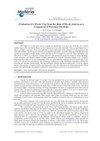Study of the interaction of the bioactive compound saponin from Glycyrrhiza glabra with a carbon nanotube matrix
IF 1.2
4区 材料科学
Q4 MATERIALS SCIENCE, MULTIDISCIPLINARY
引用次数: 0
Abstract
Saponins are bioactive compounds belonging to the secondary metabolism of plants widely used for their beneficial actions to human health. In this work the association of the saponin from Glycyrrhiza glabra with a matrix of multi-walled carbon nanotubes was promoted to obtain a composite material with improved functional characteristics. For this investigation, chemically modified electrodes (CME) based on carbon paste were developed. Firstly, a carbon paste electrode (CPE) modified with the addition of saponin (SAP) was developed. For the electrochemical optimization of this system, CPE/SAP, studies were carried out using cyclic voltammetry. The determination of parameters such as formal potential (Eo) and potential separation (ΔE) indicated that the saponin used as a carbon paste modifying agent generated a matrix that favors the transfer of electrons even at low applied potentials. The second step was performed by preparing the modified carbon paste electrode with the carbon nanotube matrix (CPE/CNT). This material, surprisingly, showed a redox pair probably due to the presence of iron atoms from the preparation method, something very beneficial for the purposes of this work. Next the saponin was associated to the carbon nanotube matrix in order to investigate the behavior of the hybrid material formed (CPE/SAP-CNT), which evidenced a significant improvement in the electron transfer process when the saponin interacts with the carbon nanotube matrix, increasing the anodic peak current by more than 3.6 times in relation to the CPE/SAP and 2.1 times when compared to the CPE/CNT. Another important issue concerns the stability of the systems, with the saponin associated with the carbon nanotube matrix presenting significantly improved stability, being able to be used for more than 8 hours or 200 voltammetric cycles with loss of signal of the order of only 2%, while the CPE/SAP showed a 60% loss of signal under the same conditions of use. Keywords: Saponin, muti-walled carbon nanotubes, modified electrodes, carbon paste.甘草生物活性化合物皂苷与碳纳米管基质相互作用的研究
皂苷是植物次生代谢的生物活性化合物,因其对人体健康的有益作用而被广泛应用。本文研究了甘草皂苷与多壁碳纳米管基质的结合,制备了具有较好功能特性的复合材料。为此,开发了基于碳糊的化学修饰电极。首先,研制了一种添加皂苷修饰的碳糊电极(CPE)。为了对CPE/SAP体系进行电化学优化,采用循环伏安法进行了研究。形式电位(Eo)和分离电位(ΔE)等参数的测定表明,皂苷作为碳糊改性剂,即使在低施加电位下也能产生有利于电子转移的基质。第二步是用碳纳米管基体(CPE/CNT)制备改性碳糊电极。令人惊讶的是,这种材料显示出氧化还原对,这可能是由于制备方法中铁原子的存在,这对这项工作的目的非常有益。接下来,我们将皂素与碳纳米管基体结合,以研究形成的杂化材料(CPE/SAP-CNT)的行为,结果表明,皂素与碳纳米管基体相互作用时,电子传递过程显著改善,阳极峰值电流比CPE/SAP提高了3.6倍以上,比CPE/CNT提高了2.1倍。另一个重要的问题是系统的稳定性,与碳纳米管基质相关的皂苷表现出显著提高的稳定性,能够使用超过8小时或200伏安循环,信号损失仅为2%,而CPE/SAP在相同的使用条件下显示出60%的信号损失。关键词:皂苷,多壁碳纳米管,修饰电极,碳糊
本文章由计算机程序翻译,如有差异,请以英文原文为准。
求助全文
约1分钟内获得全文
求助全文
来源期刊

Materia-rio De Janeiro
MATERIALS SCIENCE, MULTIDISCIPLINARY-
CiteScore
1.00
自引率
25.00%
发文量
51
审稿时长
6 weeks
期刊介绍:
All the articles are submitted to a careful peer-reviewing evaluation process by the journal''s Editorial Board. The Editorial Board, reviewers and authors make use of a web based proprietary automated tool to deal with the reviewing procedures.the Revista Matéria''s article reviewing restricted access system - SEER. Authors are not informed about the identity of the reviewers.
 求助内容:
求助内容: 应助结果提醒方式:
应助结果提醒方式:


